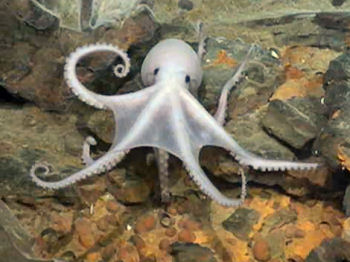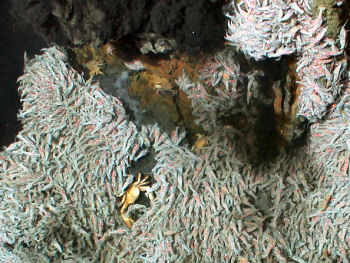Citizens of the deep
So animal life thrives around volcanic vents on the ocean floor thanks to chemical-powered microbes, rather than solar-powered plants. But to us, these remote corners of the deep sea still seem challenging places to live for other reasons. Firstly, there is high pressure of the abyss. At nearly two miles deep, the water pressure is more than 3500 pounds per square inch - roughly the weight of a mid-sized car.
People often ask whether animals 'explode' when they are brought up from the deep ocean, because of the difference in pressure. Perhaps disappointingly to some who ask the question - but not to those trying to study these creatures - most animals remain intact. Unless their bodies have gas inside them, there is nothing to expand as they are brought to the surface.

But as Charles Wyville Thompson noted back in the nineteenth century, 'stupendous pressures' are a challenge to deep-sea life. High pressure traps water molecules on the surface of unfolded proteins, often preventing them from folding up into the right shapes for them to work as enzymes. Some deep-sea creatures have different enzyme structures to reduce this problem - and their enzymes are less efficient at surface pressures as a result.
Others have also evolved 'chaperone' molecules that pull water off the surfaces of unfolded proteins, helping them to fold up correctly. As some human diseases also involve proteins not folding up properly - such as Alzheimers and cystic fibrosis - these deep-sea tricks could provide clues for new medical treatments.
Besides the high pressure at the ocean floor, deep-sea vents can also be poisonous places to live. The hot water erupting from the vents is loaded with heavy metals as well as hydrogen sulphide. Chemical reactions in the water around vents also create free radicals - highly reactive forms of oxygen that damage the molecular machinery of living cells.
The creatures living at vents have evolved measures to cope with these conditions. The tubeworms, for example, have that special haemoglobin to handle hydrogen sulphide. Microbes living on the skin of some vent animals also help to detoxify heavy metals and free radicals.

Coping with the high temperatures at hydrothermal vents is actually less of a challenge for most animals. Although the water gushing out of vents can be greater than 350 degrees C - hot enough to melt lead - it cools very rapidly on contact with cold seawater. Most vent animals live at more balmy temperatures: usually less than 30 degrees C, which is similar to shallow tropical waters.
Nevertheless there are microbes that thrive at much hotter conditions - some even live at temperatures greater than 120 degrees C. To keep working in these conditions, their enzymes often have different structures to those of other life-forms. These high-temperature enzymes have now been copied and are finding some surprising everyday uses. Some soda manufacturers, for example, use them to make the sugar in their drinks without having to cool the product down, thereby saving energy.
Page 1: A golden age of exploration
Page 2: Secret ingredients of life at vents
Page 3: Life finds a way
Page 4: Island-hopping in the abyss
Page 5: Twilight of the Gods
Science
Find out more about the Cayman Trough, undersea volcanoes, deep-sea vents,
and the inhabitants of the abyss.
What are we investigating?


